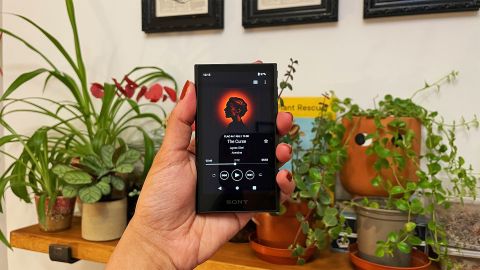When Sony announced a new Walkman earlier this year, we rejoiced. The Sony NW-A306 model packs in hi-res audio playback and multiple additional features that in essence marks it as a scaled-down version of the flagship, high-end Sony NW-WM1ZM2 player (£3299 / $3699 / AU$4999).
And then there’s the tantalisingly affordable price tag. At £349 / $350 / AU$499, the A306 is one of the more affordable hi-res players we’ve come across in recent years, and undercuts by a large margin the stellar Astell & Kern models that have dominated this category of late.
In fact, it was a much cheaper model, the Sony NW-A55L (£160 / $220 / AU$339 in 2020), that last set our portable music player world on fire on the affordable side with a 2020 What Hi-Fi? Awards win, so we’re keen to see if this feature-packed new Sony Walkman can deliver a similar winning performance.
Build & design
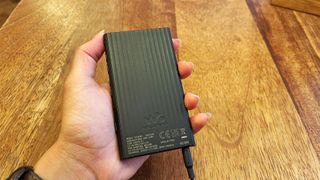
As a portable music player, the NW-A306 fits the brief perfectly. The player is compact and fits in palms and pockets alike with no fuss. We love the scalloped textured back that gives us a good grip, and how it doesn’t feel too expensive to feel like we need to be handling it with white gloves. It feels like a music player that’s meant to be used more than admired.
We spent a good month or so with the A306 sharing space with our keys, cables and mints in our bags and in our pockets, and the Walkman didn’t pick up any scratches or knocks. We would still take care not to drop it or dunk it in water, but this Walkman feels pretty sturdy in everyday use.
Whereas the more premium Astell & Kern players can need a bit of careful handling thanks to their fashionably sharp edges, the Sony’s curved edges and lightweight feel are far more forgiving and more friendly. The 3.6-inch touchscreen that dominates the front is crisp and sharp and shows album artwork in full colour, with a decent-enough contrast even in bright daylight.
The connections are minimal: you get the standard 3.5mm headphone jack, a USB-C port for charging and transferring files (a short USB-C cable is provided), a microSD card slot, and a slot for adding a lanyard loop. We like the simplicity.
There are multiple buttons on the side for power, volume changes and playback options (play/pause and skips). All buttons work responsively, although it does take us a while to get used to pressing the right buttons intuitively without looking every time.
Features
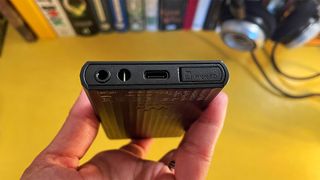
So far, so practical. But turn the Sony NW-A306 on and it suddenly becomes a bit more complicated. Because when you first turn the Sony music player on, you’re greeted with the rather cumbersome process of setting up an Android device. This NW-A306 runs on an Android 12 operating software, and much like in our review of its flagship sibling NW-WM1ZM2, we still don’t see the value in offering the full Android experience in a dedicated music player. You can, if you take the time, turn off every notification and alert that might distract you from enjoying your music on the Sony Walkman, but we wish that Sony had kept to a purer approach here. It feels at odds with the initial, beautiful simplicity of the A306 player.
The inclusion of a full Android OS and its Google apps has two real-world side effects on the A306, though. One, it makes the interface rather sluggish to use. There are intermittent stutters and delays when switching between apps, menus and selecting songs – it’s nowhere near the buttery smoothness we experience in current Android smartphones. In comparison, the more focused Astell & Kern players are far more seamless in use, responding more quickly and slickly to taps on the screen.
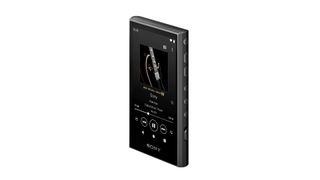
Max file support 32-bit/384kHz, DSD256, MQA
Storage 32GB (expandable by 2TB via microSDXC)
MicroSD slot? Yes
Battery life 32 hours approx.
Headphone outputs 3.5mm
Dimensions (hwd) 9.8 x 5.7 x 1.2cm
Weight 113g
Finishes x2 (blue, black)
Secondly, the Sony NW-A306 claims 32GB of onboard storage. But a closer look at the technical specs states “actual available memory 18GB”. When asked about this, Sony told us that the "Android OS system and pre-installed Google apps including Sony original music app occupy around 18GB". That means more than half of the available storage space is given up to software that is not entirely necessary.
Before we load up any music we check the player’s settings and see it’s largely true: 14GB out of the supposed 32GB is already used up, with 12GB occupied by “System”. Considering we normally find players with even a full 32GB storage not enough to store a decent hi-res music library (we estimate that 32GB will hold roughly 1,000 CD-quality songs), the 18GB of internal storage on offer here is disappointingly measly.
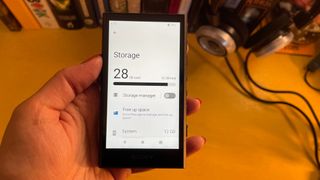
After we’ve loaded up the player with about 20 albums and a dozen additional tracks (the majority in hi-res 24-bit FLAC and 16-bit CD quality, a handful of MP3s, two DSD tracks) we’re left with just 4GB remaining. That’s rather poor. There is a microSD card slot for expanding this storage (by up to 2TB thanks to SDXC card support), but this is an additional cost.
Now that we’ve gotten all that out of the way, there is an upside if you listen to music from a variety of sources. Access to wi-fi and the Google Play Store on the A306 does mean you can download any music app – Tidal, Apple Music, Qobuz – to stream your favourite tunes alongside your hi-res files. You can also use the player as a DAC in your system, and connect it to your laptop. Hi-res file support is extensive for a player at this level: the Sony can handle playback of up to 32-bit/384kHz PCM, DSD256 and MQA file formats.
Elsewhere, it has Bluetooth 5.0, with aptX HD and LDAC codecs supported alongside the standard SBC and AAC codecs. This lets you connect wireless earbuds such as Sony’s WF-C700N or Apple’s AirPods Pro 2 to the A306, although be warned that any hi-res file will be downsampled considerably using Bluetooth.
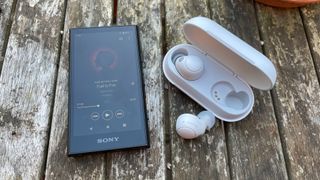
Battery life varies depending on the file type and which app you’re using to play, but as standard you should get up to 32 hours if you’re playing 24-bit hi-res FLAC files (this plummets to 14 hours if you’re playing DSD256 files exclusively). We find this to be true in real life use, with the A306 lasting a good few days without us having to reach for the charging cable.
You even get the very same sound modes as the flagship NW-WM1ZM2 model, including the Vinyl Processor (which tries to emulate the ‘warm’ analogue sound), DSEE Ultimate (which upscales and enhances low-res compressed files to hi-res quality) and a Direct mode, which disables any extra processing and keeps the original file playback as pure as possible. We end up using this mode for the majority of our testing, but it’s worth trying each mode to see which you prefer, alongside tweaking the 10-band equaliser, to suit your tastes.
Sound
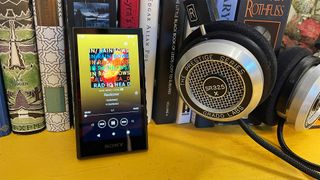
So how does the Sony NW-A306 actually sound? With the excellent Grado SR325x headphones plugged into the 3.5mm jack, we’re treated to a performance that’s admirably clean and composed with edges of notes neatly drawn. Elliott Smith’s guitar strums and soft vocals on Either/Or sound delicate yet stark against a low-noise background. Frances Quinlan’s raw, shimmering vocals rip through in Hop Along’s breezy, jangly indie-pop tunes such as How Simple.
There’s an even balance across the frequencies, with no spikey edges or flabby bottoms in sight. It’s an easy listen. We could do with a bit more wallop to the brooding undertones in The Dark Knight Rises soundtrack to keep us on tenterhooks, though.
Play songs with a more complex arrangement (Radiohead’s In Rainbows album) or that could easily become too aggressive (Disturbed’s epic Down With The Sickness), and we find the Sony player doesn’t get confused at all. It’s easy to follow each instrument’s path and interplay with each other, and the lack of any hardness means it’s comfortable to listen to over long periods of time.
The Sony is adept enough to turn its hand to various genres and even discern the differences in file qualities, but it doesn’t make a meal out of it at all. In fact, there’s a familial throughline from the high-end NW-WM1ZM2 to the A306 in terms of just how mature and capable it’s able to sound. We can spot the same sound signature, even if the detail resolution is at vastly different levels. Where the A306 differs (and has the upper hand) is with volume: it had no problem driving the Grados, and we found it played more than loud enough for our needs.
As with the NW-WM1ZM2, though, we find ourselves yearning for an ounce more dynamic punch and drive. We think the Sony A306 could sound a whole lot more fun and immersive if it let its metaphorical hair down and stayed up past its metaphorical bedtime. It’s a polite, undemanding listen that could become an absolute barnstormer with just a bit more bite, fluidity and insight.
Verdict
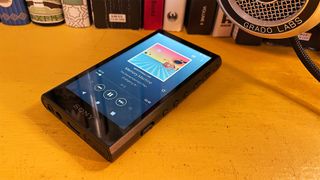
On the whole, there aren’t too many viable options at this end of the market if you’re after an affordable but decent portable music player. So it’s great to see that Sony has stepped up with a likeable player that can handle hi-res audio (even DSD).
Ultimately it stops short of getting the full five stars due to a culmination of usability issues and a lack of sonic verve, but overall the Sony NW-A306 is worth considering if your budget doesn’t stretch to the more premium Astell & Kern SR35.
SCORES
- Sound 4
- Build 5
- Features 5
MORE:
Read our review of the Astell & Kern A&norma SR25 MkII
Also consider the Astell & Kern A&norma SR35
Read our FiiO M11S review
